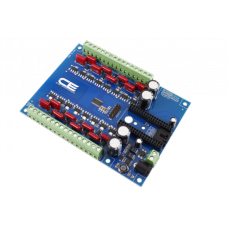PCA9685 16-Channel 8W 12V FET Driver Proportional Valve Controller with IoT Interface
This 16-Channel power FET driver allows 12-bit variable control of high-current loads your favorite IoT communications technology via I2C communications. This device uses sixteen BUK98150-55A power FETs, allowing PWM cloud control of 16 channels. Control DC Motor Speed, vary the opening of proportional valves, adjust brightness of LEDs or incandescent lighting from anywhere in the world. The BUK98150-55A is capable of controlling up to 12VDC and 5.5 Amps of current (8 Watts of Heat Dissipation), making it an ideal choice for inductive or proportional control of resistive loads. Compatible with 12VDC motors, pumps, valves, solenoids, high-power LEDs, incandescent lights, and many other types of devices. The PCA9685 chip is used as a driver for this controller, making communications easy and expandable to up to 62 devices on a single I2C port.
What is the NCD IoT Interface?
The NCD IoT Interface provides users with a means of changing or upgrading the IoT communications technology as new technologies emerge. The NCD IoT Interface is directly compatible with Particle Photon for WiFi communications, Electron for Cellular Communications, Bluz for Bluetooth. Optionally, adapters may be installed to provide a direct interface to Arduino Nano, Micro, USB, PyCom WyPy, Onion Omega, Raspberry Pi, and much more. The NCD IoT interface allows you to re-use your hardware so it never becomes obsolete! Based on I2C communications, the NCD IoT Interface uses only 2 GPIO lines of your microcontroller, freeing the rest of your CPU for other tasks.
Unlimited I2C Expansion
Based on our plug-and-play I2C interface standard, all NCD IoT devices are equipped with a I2C expansion port, making it easy to expand to a wide variety of sensors, current monitors, relay controllers, PWM controllers, and much more! We are always designing new expansions for our plug-and-play I2C framework. We are dedicated to building a product line of interconnected devices to simplify all forms of automation. Re-use or upgrade your hardware in seconds by selecting the modules that best fit your needs, and chaining them together using the included I2C expansion cables!
Features
- 12V PWM Power FET Controller Shield with IoT Interface
- Compatible with Particle Photon, Electron, or Bluz
- Adaptable to Arduino, PyCom, Raspberry Pi, Onion and more
- PCA9685 12-Bit 16-Channel 8W 12V Outputs 4096 Output Levels per Channel
- 16-Channel Variable Voltage Outputs Rated for Use with Inductive Loads
- Provides 12-Bit PWM Proportional Valve Control and Speed Control DC Motors
- Solid-State PWM Control of 12V Incandescent or High-Power LED Lighting
- 16 N-Channel BUK98150-55A 12V 5.5A Power Fets
- Designed for Resistive or Inductive Solid State DC PWM Control Applications
- I2C Expansion Port for Adding External Sensors or Controllers
Enter the code in the box below:



